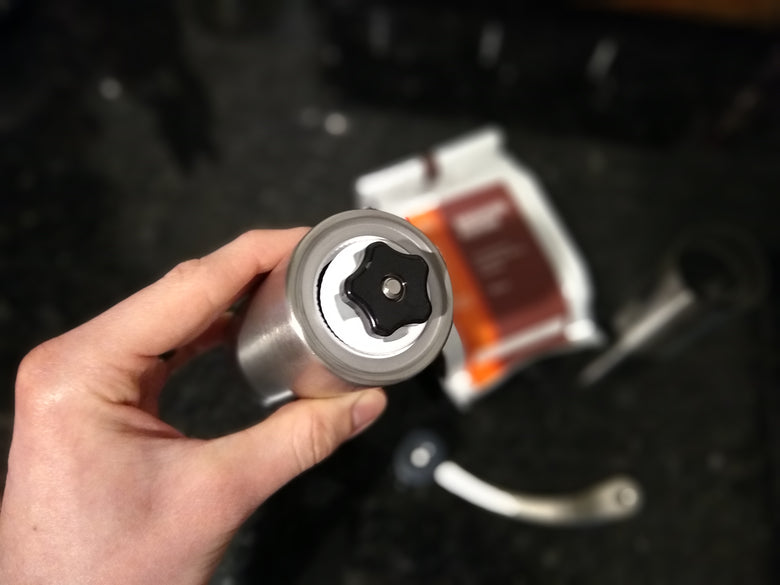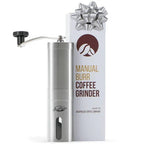Rocks and unroasted beans can quickly break your coffee grinder burrs, and it can be quite obvious when it happens. But the slow, inevitable dulling of your burrs from normal use is not so easy to detect.
Over the course of several dozen bags of coffee, that slow change is barely noticeable.
Ceramic burrs tend to dull slower than stainless steel burrs, but they’re more susceptible to clean breaks and cracks from rocks and other hard objects that find their way to the beans.
I’ll share with you three easy ways to confirm if your burrs are ready to be replaced. But first, let me show you what you have to look forward to.
Read: How To Pair Your Coffee Brewer With Its Perfect Grind Size
Fresh Burrs Brew Better Coffee
Chances are, your coffee quality has been going downhill for some time. By the time most people realize it’s time for burr replacements, their coffee flavor has already been on the decline for a couple months.
This is largely to do uneven coffee grounds, which don’t brew at the same pace and end up brewing imbalanced coffee. The extra small grounds extract too much, making bitter coffee. The extra big grounds extract too little, adding sourness.
It’s sad, but actually, I’ve got good news for you.
Your coffee’s about to get a lot tastier.
When you switch out those burrs, you’re going to notice a boost in flavor and balance immediately in your brew. The burrs will be sharper, grinding with more consistency and precision, which will lead to a better mug.
I know how easy it is to put off changing your burrs, but if it’s really their time, you’ll love the results.
Read: Want To Be A Coffee Aficionado? Here Are 5 Things You Need To Know
Now that you have this flavor boost to look forward to, let’s explore these four ways to tell if your burrs need replacing.
1. The Burr Edges Feel Dull
Here’s the most obvious way to tell if your burrs are getting dull: feel them!
If you can remember what your burrs felt like brand new, this is the easiest way to tell if they need replacing. If you’re like me though, you probably won’t be able to remember the difference by memory.
Here’s how to do it.
Disassemble the grinder, wipe down the burrs with a clean paper towel, and carefully rub your finger over the edges. Do they feel sharp? Do they feel like the edges aren’t as defined as they used to be?
Read: The Perfect Water Temperature For Coffee Brewing
Use your best judgement here. Even if you can’t remember what the burrs felt like brand new, if they’re clearly dull, you need new burrs.
2. You Keep Having To Grind Finer
If you feel like you’re slowly having to make your grind size finer and finer, it could mean your burrs are close to replacement time.
For example, if you used to grind at a 9 setting for pour over coffee, but you now find yourself grinding at a 8, 7, or even 6, your burrs are probably on their way out.
This happens when the burr edges become dull. Without that razor sharpness, they don’t grind with as much precision, and the result is that beans are ground more coarsely.
By using a finer setting, you can still kind of achieve the same fine results as before, but you’ll still run into consistency problems. This is more of a band-aid approach, rather than a real solution.
Read: How To Read Coffee Packaging Like A Pro
3. The Grounds Are Increasingly Inconsistent
Dull burrs slowly do less grinding and more mashing. Those sharp edges are no longer slicing the beans precisely - they’re just crack and smashing them into smaller pieces.
Grind a few beans and take a look at the results in your hand. Are the grounds all over the place in terms of size? That’s not good.
Keep in mind that all grinders produce a range of grind sizes, even with brand new burrs. So don’t freak out if there’s a little diversity in the grind size. What you’re looking for are grounds so inconsistently sized that there’s no clear single size that makes up the majority of the grounds.
Read: Why Your Grinder Is Your Most Important Coffee Gear
Brewing coffee with inconsistently sized grounds is a great way to brew an imbalanced mess. Like I said, the extra large grounds (sometimes called “boulders”) under extract and add an unpleasant sourness to your mug. The tiny grounds (often called “fines”) over extract and produce a lot of bitterness.
The real issue here is grind size inconsistency, but the consequences are less tasty coffee, which is what most people first notice.
4. Grounds Are Coming Out In Clumps
This is an easy tell for grinders designed specifically for espresso. When the burrs are in the early stages of dulling, they can start dispensing small clumps of grounds.
Now, these clumps can easily be broken up with your finger. They’re not really an issue and don’t mess with your flavor, but they’re an early reminder that your burrs are no longer considered new.
Read: The Ultimate Guide To Espresso
When the majority of your grounds from your espresso grinder come out in clumps, it’s time for burr replacements. Chances are, by this point, your espresso flavor has suffered some loss of quality.
How To Prolong Burr Life
Some wear and tear over time is normal - no burrs last forever. But here are some ways you can keep your burrs healthy for a long life.
Don’t grind non-coffee objects. You shouldn’t really be grinding anything other than whole roasted coffee bean, so keep an eye out for unroasted beans or tiny rocks that sometimes find their way into bags. They’re both rare, but be mindful.
Grind Upright. Grinding coffee at an angle puts uneven pressure on the burr shaft, causing the burrs to wear unevenly. This is a quick road to inconsistent grounds and imbalanced coffee.
Keep them clean. Clean them every now and then to keep oils and micro-grounds from attaching for the long-term and causing inconsistent results.
See The Signs Easily In Great Coffee
Avoid bad tasting coffee by spotting these signs early and being prepared to replace your grinder burrs when the time comes. It’s not something you should be looking for every day, but keep an eye out for these signs and do a burr sharpness check every couple months.
Like I said, most people notice they need new burrs when their coffee stops tasting rich and balanced. Noticing that decline in flavor from dull burrs is nearly impossible with low-grade beans.
Low-grade beans come from farms that don’t pick evenly ripe cherries, which means the beans are not all the same weight or density. This produces a lot of variation between beans in a single bag, making it impossible to tell if the issue is the beans or the burrs.
The easiest way to stay on top of your grinder burrs is to simply brew high-quality, freshly roasted coffee beans.
Transform your daily coffee routine with the rich flavors and vibrant aromas of freshly roasted, specialty-grade beans. Not only will your coffee taste better, it’ll be easier to keep an eye on how your burrs are doing.




